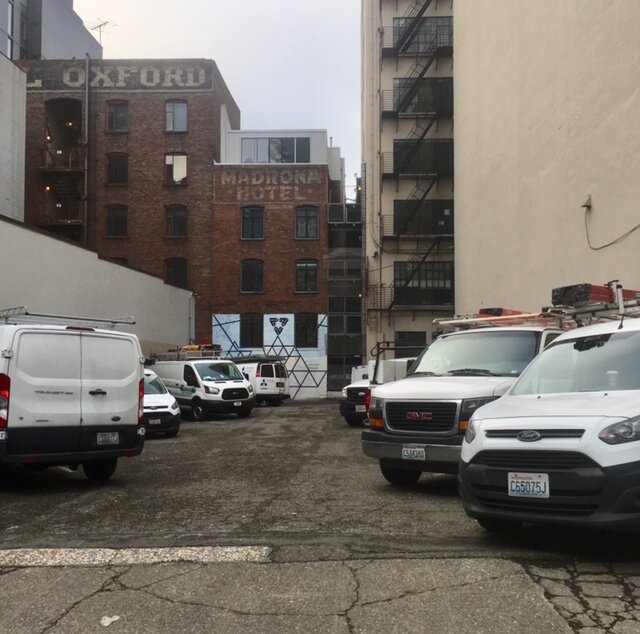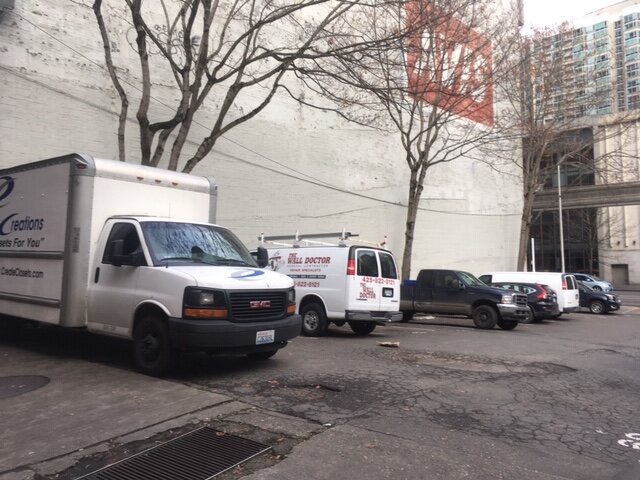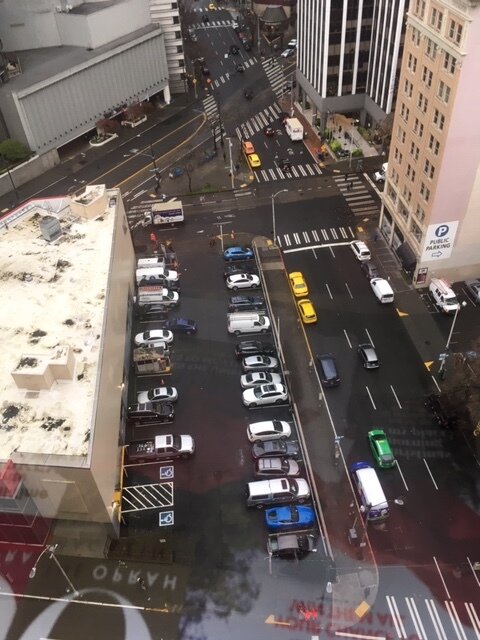Surface parking lots: a hot button issue

Today’s blog post is the fifth in a series where we look at Seattle’s land use history and decades of missed opportunities for comprehensive infrastructure planning for transportation and housing.
Parking is a Seattle hot button issue. By one account the City has 1.6 million residential parking spots—that’s two for every resident. But parking spots for service vehicles are a different story.
Downtown surface lots, the last safe haven for oversize work trucks and vans, are systematically being replaced with 40-story commercial and residential towers. Each tower will require an army of repair, installation and service professionals over the life of the development. But their garages are only designed to hold passenger vehicles and vendors are feeling the squeeze.
A 2019 UW Freight Lab vehicle cordon study tells the story in numbers:
Each day over 40,000 commercial vehicles enter the City Center for construction, waste management, service and deliveries.
The largest percentage, over one-third, are service trucks and vans.
Once downtown they battle with freight, delivery and passenger vehicles to find shrinking curb space. Another UW study explains:
Service vehicles make up 36% of vehicles parked along the curb
44% of them park for more than 30 minutes and 27% need an hour or longer.
As parking lanes are converting to bus and bike use, one contractor told the Seattle Times, “ . . . you hope to heaven to find a parking lot within walking distance of your client, just in case you left anything in the truck by mistake.”
The UW study concludes, “Because service vehicles make up such a big share of total CVs (commercial vehicles) at the curb, this may have an outsize impact on parking space turn rates.” The study emphasizes “the importance of factoring (service truck) behavior and future demand into urban parking schemes.”
If only City planners would listen. The Seattle Department of Construction and Inspection (SDCI) claims its mission is Helping people build a safe, livable, and inclusive Seattle. If so, livability starts with planning for the needs of residents.
In the past three years surface lots at 2nd and Pike #3009156 and 2nd & Pine #3014773 have been replaced by towers. The same is set to happen at five more lots. (#3018037, #3026266, #3026416, #3033067, #3033162) None of these is built or designed to accommodate over-height service vehicles. Neither are the large downtown commercial garages. Even the Columbia Tower garage cautions “Standard size vehicles only. No minivans, midsize or large SUVs, pick-ups or trucks.”
This isn’t rocket science. Whether a home is on the ground or 40-stories high, it requires the service of plumbers, electricians, cable installers, contractors and a host of other repair and maintenance professionals. They don’t arrive via bus or bike but in vans and trucks with ladders and other equipment.
Bottom line: If we want a City that works, SDCI must require garage space for working vehicles.




Stay tuned for future posts in this series, exploring how current Seattle development and land use policy is impacting Seattle transportation and sustainable housing.
Be sure to read additional posts in series:
Will Seattle’s 19th century transportation grid continue to survive business as usual?
Another rubber-stamped tower is designed to fail
Demands of e-commerce won’t be met by paper band aids







